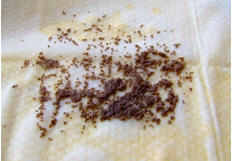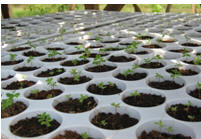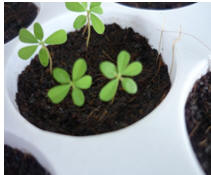 |
 |
 |
| Figure 2. Seeds of amaranthus and germination of the plants | ||
|
|
|
In order to compare the efficiency of fertilizing different types of organic manures and inorganic fertilizer on the biomass and characters of some active substances in Phyllanthus amarus plant, about 1650 plants were grown in a complete randomized design (CRD) with five treatments and three replicates. The treatments were based on types of manure used no manure (MN), adding NPK in the soil (IO), chicken manure (CM), pig manure (PM) and cow manure (COM). Each replicate had a surface of 4.5m2 (1.5m x 3 m) called plot and for the fertilized treatments, each plot were added with manures or NPK to obtain the same total nitrogen of 68g.
There were significant differences between DM of stems, leaves and roots from CM, PM, COM, IO treatments and that of NM treatment (stems: 118± 31,4; 124,2 ± 51,2; 105,9 ± 16,3; 102,2 ± 46,3>48 ± 9,8, P<0.05; leaves: 162,6 ± 26,7; 138 ± 27,5; 109,1± 21,3; 144,8 ± 49,1 > 103,8 ± 21,3, P<0.05; roots: 24,1 ± 4,3; 23,3 ± 2; 22,5 ± 2,5; 23,8 ± 7,6> 16,7 ± 3,8, P<0.05). The length of roots and stems from plants fertilized by animal manures and IO were significantly longer than that of NM treatment (P<0.05; P<0.01). Phyllanthin, hypophyllanthin and niranthin concentrations in roots of no manure treatment were significantly higher than those of animal manure and IOF treatments (P<0.05). Total hypophyllanthin, niranthin contents in roots of 1m2 from animal manure and IO treatments were markedly lower than that of no manure treatment (P<0.05). However, total hypophyllanthin content in leaves of 1m2 from animal manure treatments and IO treatment were all higher than that of no manure treatment (P=0.05). Moreover, total phyllanthin, niranthin contents in leaves of 1m2 from animal manure and IO treatments tent to be higher than that of no manure treatment.
These days, more and more people including scientists, patients and traders are interested in medicinal plants due to their effective uses in curing diseases. Among them, Phyllanthus sp. such as P. amarus, P.niruri, P. urinaria are well-known for the treatments of liver, kidney diseases in traditional books and practice. Especially, they have a remarkable effect on hepatitis B patient due to their anti-virus hepatitis B character in human (Ott et al 1997; Wang Xin-hua et al 2001). Kodakandla Venkata Syamasundar et al (1985) found that phyllanthin and hypophyllanthin in P. niruri have the hepatoprotective function. Moreover, in Vietnam, these plants have been using to treat acnes, ophthalmitis, snake bite, fever (Do Tat Loi 2004). Although they grow widely in nature, the Vietnamese farmers are trying to cultivate them as a kind of crop to supply more material for medicinal production. Furthermore, the income from P. amarus cultivation is improving the economic conditions of poor farmers (http://www.thanhnien.com.vn/News/0109/Pages/200925/20090615223713.aspx 2009). However, because of the medicinal purpose, chemical fertilizers should not be used and organic fertilizer like farm yard manure is the best fertilizer to think about. Animal dung is claimed as the environmental problem and the source of green house gases (GHGs) in the modern time when animal production is in large scale (Humane Society of the U.S. (HSUS) 2010). Therefore, applying farm manure fertilizer is the good way to reuse waste nutrient by plants and reduce GHGs. Animal manure are different in total N, P and K content, chicken manure has highest total N, P and K content compare with cow and pig manure (Westover 1926); so will they give the same yield of biomass and phyllanthin, hypophyllanthin content of Phyllanthus amarus? There is no clear information about that matter, so it should be more study about which kind of manure is the best to maximize the plant yield.
The objectives of cultivating Phyllanthus amarus is to compare the biomass yield, phyllanthin, hypophyllanthin and niranthin contents in the different part (leaves, stem, root) of Phyllanthus amarus among treatments (chicken, cow, pig manure and inorganic fertilizer).
The experiment was conducted in the experimental farm of the Animal Husbandry and Veterinary Medicine Faculty of Nong Lam University, Ho Chi Minh City, Vietnam. This area is in Southeastern Vietnam, and has a tropical monsoonal climate, with a rainy season from May to October and a dry season from November to April. The characteristic of the soil is sandy. The average temperature is 28°C with high humidity. The duration of this study was 120 days, from February to May, 2011.
The experiment was a completely randomized design (CRD), with 5 treatments and 3 replicates. Each replicate in the experimental field was a plot with about 110 plants grown on the surface of 4.5m2 (1.5m × 3m) and 20 cm high (Figure 1).
The treatments were:
Chicken manure (CM): 68g total Nitrogen from chicken manure
Cow manure (COM): 68g total Nitrogen from cow manure
Pig manure (PM): 68g total Nitrogen from pig manure
Inorganic fertilizer (IO): 68g total Nitrogen from inorganic fertilizer
No manure (NM): No manure is applied when sowing and planting
Figure 1. Experimental layout |
After collecting, animal manures were processed to become well rotted manures. Chicken manure mixing with small amount of husk was purchased from laying farm. Pig manure was from sow farm and cow manure was collected from cows in university farm. Inorganic fertilizer was produced by My Viet company containing NPK (16-16-8): 16 % total Nitrogen, 16 % P2O5 , 8 % K2O, minor and micro substances. Manures were supplemented with 2% limestone and 1% P2O5 for processing. They were put in a plastic sheet and divided into many layers, one manure layer then one mixture of limestone and P2O5. Next, another plastic sheet was used to cover the manure pile, but a whole was made on the top for watering to make sure the manure moisture is 60 to 70%. This helped to reduce the harmful microorganisms and parasites in fresh manures. After one month, well rotted manures were ready to use.
The seeds were supported by Center of Medicinal plant research and Production in the Middle of Vietnam. After soaking in 35-370C water in six hours, the seeds were germinated within three to four days on wet tissue. Then the young plants were grown in nursery plates which had many small holes with soil. Finally, a light irrigation is needed just after transplanting for moisturizing the soil (Fig. 2). When plants reach 10 cm tall after about 39 days, the strong ones were chosen for transplantation in the experimental field at horizontal 8 plants and vertical 15 plants.
 |
 |
 |
| Figure 2. Seeds of amaranthus and germination of the plants | ||
The soil for planting Phyllanthus amarus was fertilized with animal manures according to treatments 1 week before transplanting. Based on the amount of total Nitrogen in the manures, the amount of each type of manures was used 425g for inorganic fertilizer, 5.074kg for chicken manure, 10.982kg for pig manure and 19.085kg for cow manure. After transplanting, irrigation was taken place immediately to ensure the good development of the root. Depending on the precipitation, the irrigation was applied everyday before 9 am. in the dry time and no watering in the rainy time. Water was from the well. Moreover, weeding will be done every week and no commercial herbicides was used on the field to prevent the residual substances in products. Plastic net was used to cover the surrounding area to protect plants from animal and insect damages.
Well rotted animal manures were sampled for analyzing dry matter (DM), total nitrogen (N), Calcium (Ca), Phosphorous (P) and ash. The analysis were done at Department of Animal Nutrition, Nong Lam University.
Leaves, stems and roots of 20 plants from each plot were mixed to take 6 samples of leave, stem and root for analysis of phyllanthin, hypophyllanthin and niranthin. There were total 90 samples for analysis. These compounds were analyzed at Institute of Chemical Technology after harvesting.
After 50 days of growing, all plants in each plot were harvested carefully to keep the whole parts from leaves to roots. Then they were washed off soil, weighed and counted for fresh weight and number of plants in one plot. 20 P. amarus plants were randomly chosen in each plot to measure for stem and root length. Then they were separated for leaves, stems and roots to weigh.
The data were analyzed by Analysis of variance (ANOVA) using the CRD procedure of the Minitab software (version 13.3). Sources of variation were: animal manures and error.
The composition of soil in the farm is shown in table 1. The soil is sandy and tends to be acid.
|
Table 1. Soil compositions |
|
|
|
Composition |
Results |
|
|
pH (H2O) 1:5 (%) |
5.27 |
|
|
Organic carbon (%) |
1.22 |
|
|
Total N (%) |
0.063 |
|
|
|
Sand (%) |
58 |
|
Clay (%) |
15.6 |
|
|
Humus (%) |
26.4 |
|
|
Percentage of composition based on raw material. |
||
Table 2 lists the characters of well rotted manures from chicken, pig and cow. Well rotted chicken manure had highest total nitrogen content compared to those of pig and cow.
Table 2. Well rotted manure compositions (based on dry matter, except for DM which is on fresh basis) |
|||
|
|
Chicken manure |
Pig manure |
Cow manure |
|
DM (%) |
39.1 |
42.4 |
21.1 |
|
Total N (%) |
3.4 |
1.46 |
1.69 |
|
Total K (%) |
2.18 |
0.78 |
0.71 |
|
Organic carbon (%) |
28.0 |
16.9 |
72.7 |
|
Total P (%) |
1.71 |
2.19 |
0.95 |
There are significant differences in dry matter weight of leave, stem and root on 1m2 among treatments showed in figure 3. Leave weight of chicken manure group was significantly higher than those of cow and no manure (162.6g>109.1g>103.8g; P=0.014). Moreover, the stem yield of no adding manure treatment was the lowest yield among five treatments (48g; P=0.008). Weight of stem from pig and chicken fertilizer plots tent to be higher than cow manure and inorganic fertilizer (124.2g>118g>105.9g>102.2g). Similarly, root yield of no manure was still the lowest yield (16.7g; P=0.046).
Adding well rotted manures or fertilizer could help in improving plant yield in terms of leave, stem and root weight, because of the nutrients supplied to the plants. Especially, chicken manure tent to be the best fertilizer in increasing the yield, while it was used with only small amount compared to other fertilizers. The total nitrogen content of fertilizer and manures treatments was the same, this indicated that other components also had effects on the plant yield.
|
|
|
Figure 3. Dry matter weight of leaves, stems and roots on 1m2 of treatments |
Table 3 shows that stem and root lengths of no manure treatment were all significantly lower than those of the other treatments. The stem lengths of pig, cow and chicken manure treatments were significantly higher than inorganic fertilizer and no manure groups (70.5cm>70.2cm>66.3cm>62cm>43.9cm; P<0.01). The average root length of plants treated by cow manure was significantly higher than that of no manure (22.2cm>19.6cm; P=0.021). Furthermore, root/stem ratio of no manure group was markedly higher than those of other treatments (47.6; P<0.01). The stem lengths of fertilized plants in this experiment were higher than those of Phyllanthus amarus plants grew in different altitudes (from 114 - 5295 feet) in India (from 27.3cm to 58.71 cm) (Khan et al 2010). The long roots in NM group indicated that due to lack of nutrients, the root in NM treatment was well developed in order to find more nutrients for the plants.
|
Table 3. Length of stem and root and their ratio of treatments |
|||||||
|
|
NM |
IO |
CM |
PM |
COM |
SEM |
P |
|
Stem (cm) |
43.9c |
62b |
66.3ab |
70.5a |
70.2a |
10.7 |
0.000 |
|
Root (cm) |
19.6b |
21.2ab |
20.5ab |
22.1ab |
22.2a |
4.88 |
0.021 |
|
Root / stem (%) |
47.6b |
36.1a |
31.5a |
31.7a |
32.2a |
11.3 |
0.000 |
|
Means with dissimilar superscripts in a row differ significantly (P<0.05) |
|||||||
Differences in concentrations of phyllanthin, hypophyllanthin, niranthin in leave, stem and root among treatments were presented in table 4. There was no difference in phyllanthin concentration in leave and stem among P. amarus plants treated with many types of manure, fertilizer and no adding manure (P>0.05). However, this concentration in root of plants not fertilized was clearly higher than that of using inorganic fertilizer group (0.027>0.006; P=0.027). Moreover, it also tent to be higher than those of other treatments. For hypophyllanthin concentration, there were trends that this parameter in leave of NM group was lower than the other groups (P=0.075) and stem hypophyllanthin concentration was higher than the other treatments (P=0.065). Nevertheless, this concentration in root of NM treatment was 0.003 mg/g compared to those of other treatments which were lower than limit of detection. There was also no difference in niranthin parameter in leave and stem among treatments (P>0.05). But in root, NM treatment still had highest concentration (0.045mg/g; P=0.015). The higher concentration of phyllanthin in leaves compared to those in stem and root in this study was also match with this concentration in Phyllanthus amarus plants collected at different places in in India (Khan et al 2010). Maybe the malnutrition in the soil prevented the stem and root in NM treatment from transporting these substances to the leaves. The lack of some nutrients in the soil of NM treatment such as P, K, N may reduce the biosynthesis of phyllanthin, hypophyllanthin and niranthin in the leaves.
|
Table 4. Phyllanthin, hypophyllanthin, niranthin concentrations in leave, stem and root of treatments |
||||||||
|
|
|
NM |
IO |
CM |
PM |
COM |
SEM |
P |
|
Phyllanhin |
Leave (mg/g) |
|
|
|
|
|
2.52 |
|
|
Stem (mg/g) |
|
|
|
|
|
0.13 |
|
|
|
Root (mg/g) |
|
|
|
|
|
0.009 |
|
|
|
Hypophyllanthin |
Leave (mg/g) |
|
|
|
|
|
2.61 |
|
|
Stem (mg/g) |
|
|
|
|
|
0.09 |
|
|
|
Root (mg/g) |
|
|
|
|
|
0.008 |
|
|
|
Niranthin |
Leave (mg/g) |
|
|
|
|
|
2.81 |
|
|
Stem (mg/g) |
|
|
|
|
|
0.15 |
|
|
|
Root (mg/g) |
|
|
|
|
|
0.024 |
|
|
|
“-“ lower than limit of detection; Means with dissimilar superscripts in a row differ significantly (P<0.05) |
||||||||
The total yields of three substances in leave, stem and root on 1m2 of five treatments were showed in table 5. There was no significant difference in the yields of leave, stem, root phyllanthin, stem hypophyllanthin and leave and stem niranthin (P>0.05). While, leave hypophyllanthin yield of NM group was significantly lower than IO, CM, PM and COM groups (1475mg>1415mg>1260mg>1215mg>639mg; P=0.05). This is due to the low concentration in leave and low leave weight yield. The root hypophyllanthin yield only had in NM plots (0.03mg/1m2). The root niranthin yield in NM plots was highest (0.62mg) compared to other treatments (P=0.021).
|
Table 5. Phyllanthin, hypophyllanthin, niranthin contents in leaves, stem and root on 1m2 of treatments |
||||||||||||||
|
|
|
NM |
IO |
CM |
PM |
COM |
SEM |
P |
||||||
|
Phyllanhin |
Leave (mg) |
877 |
1466 |
1635 |
1456 |
1332 |
445 |
0.112 |
||||||
|
Stem (mg) |
13.3 |
6.2 |
16.3 |
17.6 |
15.9 |
12.4 |
0.608 |
|||||||
|
Root (mg) |
0.39 |
0.15 |
0.29 |
0.27 |
0.29 |
0.16 |
0.177 |
|||||||
|
Hypophyllanthin |
Leave (mg) |
639b |
1475a |
1415ab |
1260ab |
1215ab |
443 |
0,05 |
|
|||||
|
Stem (mg) |
8.58 |
1.76 |
6.54 |
13.25 |
10.17 |
8.23 |
0.304 |
|
||||||
|
Root (mg) |
0.03 |
- |
- |
- |
- |
0.07 |
0.426 |
|
||||||
|
Niranthin |
Leave (mg) |
828 |
1403 |
1409 |
1341 |
1310 |
428 |
0.199 |
|
|||||
|
Stem (mg) |
12 |
4.4 |
14.2 |
20.4 |
14.5 |
13.3 |
0.511 |
|
||||||
|
Root (mg) |
0.62a |
- |
0.07ab |
- |
0.11ab |
0.38 |
0.021 |
|
||||||
|
“-“ lower than limit of detection; Means with dissimilar superscripts in a row differ significantly (P<0.05) |
|
|||||||||||||
Using fertilizer or animal manures showed clear improvement in Phyllanthus amarus yield in terms of dry weight, stem and root length, phyllanthin, hypophyllanthin and niranthin contents in leave.
Animal manures had better effects on plant yield than inorganic fertilizer in improving stem length, dry weight and substances contents, although these effects were not very clear.
Well rotted chicken manure can be used effectively because it could increase plant yield with only small amount.
The authors gratefully acknowledge the support for this research received from the MEKARN program financed by Sida.